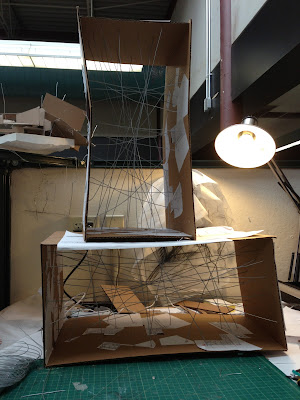Very quickly I saw that cutting it off made the spaces very unstable. Cutting the wires took them out of the tension created by the box so I had to go back to make the object stable.
Being out the box the object reads completely differently. Some parts aren't as successful as they were inside the box, but overall it has a really interesting relationship with the ground.
Gravity wants to pull the object down as the wires seem to barely hold it together, but that tension, between it falling apart/ breaking and it somehow holding itself together, makes this experiment successful.
Although I liked the outcome of the process I decided to proceed with the object inside the box. The fact that most of the original qualities of the object were lost when cut puts less importance on the box and the wire process.
The next step is to explore these spaces in drawing, with the following goals in mind:
- Finding a "ground" line within the box.
- Start thinking about manipulating the box itself so its not simply a shell and rather interacts with whats going on inside.
- Taking out some of the "excess" wires that crowd spaces.
- Think about cutting certain wires so they switch to being in compression( column-like) rather than all in tension.
.




















































